

The Puma has the same adjustable leg loops, six diagonally slanted gear loops, one rear gear loop, floating waist belt and twin Hypalon ice screw racking system (more on these later), as the flagship, do-everything, unisex DMM Renegade. The only really obvious difference is the colour. Is the Puma purple because it's not too girly, but a bit girly?
"Spot on, and it's been a popular choice according to the feedback we have received," DMM's Product Developer Graham Desroy told me. There are other differences though, of course.
If you've studied the female form, or own one, you'll know there's usually a bigger difference between women's hip and waist measurements than men's, and their rise (waist to crotch) is longer.
The Puma's dimensions suggest women have fatter thighs than men too, but Graham says "Absolutely not – women have a slimmer waist to leg ratio!" The larger leg loops means the Puma is slightly heavier than the corresponding size Renegade though (see size chart below).
So, basically the Puma offers ladies better comfort and fit; those size XS to M, that is. The Puma XS waist cinches to 23 inches at its minimum, so it can fit girls down to around age 11, and DMM are currently sampling an XXS size. Apparently, though, they've found the unisex Renegade fits the dimensions of most Large women fine.
What's the Puma like?
The Puma arrived in February, and I took it on some winter trips abroad. You want your gear to work perfectly when your daily breaks are a quick choice between a wee, a snack or adjusting layers while fiddling with ski skins/crampons/harness and making sure your gloves don't blow away or fill with snow. While I vividly remember a pair of ski skins that kept biting my freezing fingers, the Puma wasn't fiddly to adjust, it wasn't heavy or restricting, it didn't absorb snow or hog space in my pack, there were no uncomfortable rubs when worn with a rucksack all day. It attracted no unladylike words. It just worked.
Thinking about it, the Puma has since provided plenty of unobtrusive comfort and support on rock, too. Supportively providing seven, spacious gear loops, so I can look down and clearly see neat rows of protection spread out when scared on lead; offering comfort if I fall frustrated off the crux of steep and hard routes on second (enough padding without being bulky); and everything in between. It's ergonomically shaped for gymnastic movement and, while its feature set is overkill for sport routes, it's lightweight enough for those wanting one harness for everything.
The Puma has plenty of well thought out features for all seasons...
Fit
Unisex harnesses can mean trailing webbing ends dribbling everywhere for girls with their 'slimmer waist to leg ratio'. The Puma fits me very neatly and feels less bulky than the unisex harnesses I've worn before, too, as the waist belt padding is shorter and it has a very ergonomic shape: measuring 8.8cm at the back and tapering up to 5.8cm at the sides. It's fully adjustable with 'Slide Lock' buckles (don't call them 'Ziplock', that's Wild Country's word!), and I found these straightforward to completely undo and refasten if wearing skis.
Weight
The Puma isn't the lightest all-round use female-specific harness. The Arcteryx R280 is 287g, the Petzl Luna is 410g; in comparison the XS Puma is 430g. It depends on your priority though: the Puma has more features. On the whole I think the Puma walks a good line between comfort, support and weight for a do-everything, fully adjustable harness that can neatly swallow a full trad rack, and has a twin Hypalon ice screw racking system for winter days out, too.

Hypalon what?
'Hypalon ice screw racking system' is a grand name for three inches of heavy duty nylon with rows of holes punched in it (see pic left). A simple but effective design, there are two of these sewn into the waist band. You can push a krab through the holes, then clip things onto it, such as ice screws, or ice tools when abseiling. These don't necessarily remove the need for ice screw racks, but make even more storage space.
Gear loops
The Puma, designed specifically for trad-minded British climbers who want to do everything else as well, has seven big ones. Yes, seven. There's plenty of racking for the longest of pitches, or for those who like to lace routes. I've liked having all my gear well spread out so I can find what I need - and quick! The gear loops themselves are plastic covered soft ones as opposed to plastic moulded ones (it's personal preference on this, they do the same thing), and they're diagonally slanted so DMM could place them closer together, and fit them all on.
Waistbelt construction
Nowadays harness manufacturers have all kinds of fancy technologies for reducing weight while still distributing load effectively. The Puma sits in the middle of the market on this: not as bulky as some, but more padded and stiffer than others, such as Black Diamond's 'Kinetic Core Construction' harnesses, which have several crystal polymer fibres along the length of the core, laminated between lightweight taffeta (explained in this review of the Xenos). Similarly superlight, Arc'teryx's harnesses use 'Warp' technology to spread the fibres of the webbing out, to produce the harness padding and its strength.
I asked DMM what's special about the Puma waist band construction:
Graham Desroy, DMM Product Developer
DMM Puma
- Padded adjustable shaped leg loops with structural binding for greater comfort and support
- 6 high capacity diagonal gear loops plus central rear loop
- Twin hypalon ice screw racking system
- Free floating waist belt for perfectly centered racking
- 20mm belay loop rated at 25kN
- Weight: 430g in size XS
Floating waistbelt
My favourite feature on the Puma is the 'floating waistbelt'. If you're confusedly trying to visualise this, basically the waist padding with attached gear loops can move along the waist webbing, so you can keep your gear central, without having two buckles (one at either side). This centralising idea wasn't invented by DMM: the Troll climber's belt back in the late '60s and early '70s had a floating waist belt (Graham used to work for Troll, but not then!), and since then, various others have done this. It's the first time I've owned a harness like this though, and I like it.
Other little details
Other useful features include that the tie-in point is protected by a layer of fabric in a highlight colour so excessive wear is easily seen, and there are twin drop away bum straps. The latter are easy to undo, which is important when desperate for a call of nature.
Summary
It's not the lightest female-specific harness on the market - while not bulky the waistband is more padded and stiffer than some others - but this harness has great features for all seasons, it's stream lined and it neatly tidies away the biggest of racks. I think it's a bargain do-everything harness at £70.
PRICE: £70
MORE INFO: On the DMM Website




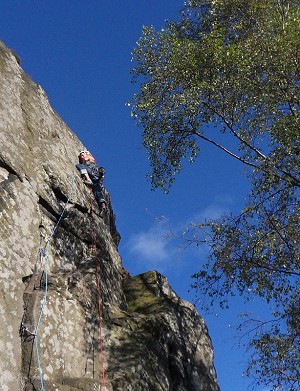
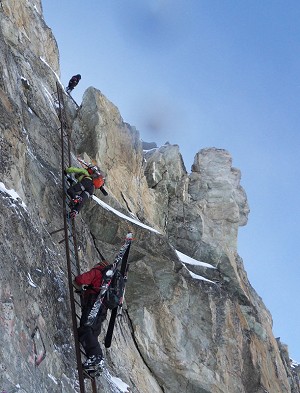
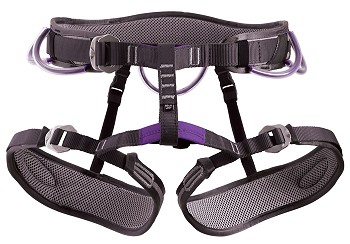

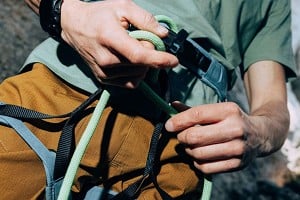
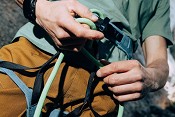




Comments